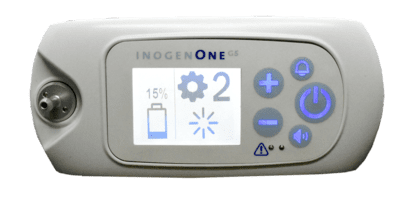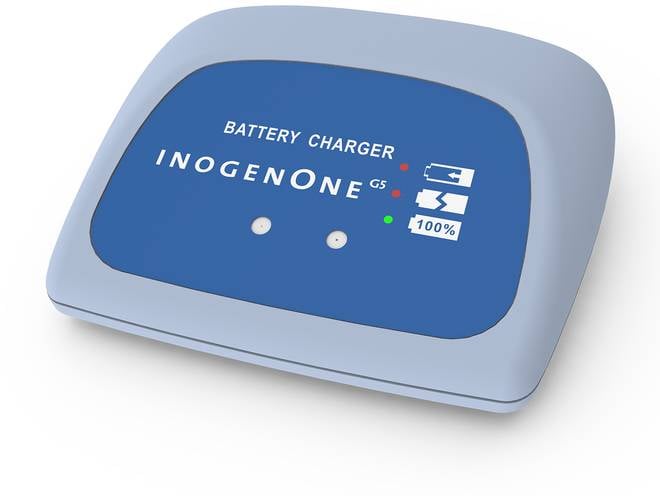-png.png)
Believe it or not, oxygen has been used for medical purposes for quite some time. The first recorded use of medical oxygen was in 1885 when it was us
ed to treat pneumonia and other respiratory illnesses. But back then, oxygen therapy wasn’t what it is today. Doctors were unaware of exactly how oxygen should be used, what it could treat, and the best way to administer it.
At the turn of the 20th century, medical oxygen saw some major advancements. A nasal catheter was invented to improve the way oxygen was administered and scientists learned of the benefits of oxygen when treating chronic lung conditions like COPD. Due to the rapid advancement of aircraft technology before World War 2, oxygen masks were implemented into planes, allowing pilots to fly at higher altitudes.
In the 1970s, a number of studies were conducted that aimed to determine the necessary duration of oxygen therapy in order to maximize its clinical benefits. Oxygen tanks — still bulky and cumbersome — could finally be prescribed for in-home use. And despite the limitations, respiratory patients were able to experience significant relief from their symptoms.
At the start of the 21st century, portable oxygen cylinders provided some freedom for respiratory patients; but without making them bigger and heavier, people had a very limited amount of oxygen to work with. What’s more, there were still many safety concerns when it came to carrying compressed oxygen in public areas. It wasn’t until the invention of the portable oxygen concentrator that people could expect to retain all their freedom and independence while receiving the oxygen they need.
-min.png)
After nearly 20 years of refinement and improvement, portable oxygen concentrators have become the industry standard. POCs like the Inogen One G5 are so small and lightweight that they can fit inside a purse. Because oxygen concentrators contain no compressed oxygen, they’re much safer and more convenient to use in your day-to-day life.
In this post, we’re going to take a look at just how far oxygen therapy has come and how the Inogen One G5 has revolutionized the way oxygen patients live.
{{cta('fa8abc2a-1e88-4fa3-82fd-1cb5b9ed43b2','justifycenter')}}
What is the Inogen One G5?
The Inogen 1 G5 is the latest pulse flow portable oxygen concentrator produced by Inogen. It’s the newest in a line of POCs that has aimed to make oxygen therapy more convenient and accessible for the average person. The term “pulse flow” refers to the way oxygen is delivered. Rather than putting out a constant stream of oxygen, these devices closely monitor a patient’s breathing pattern and administer oxygen only when it’s needed.
.png)
The Inogen One G5 works by drawing in air through its intake vents. Nitrogen — which makes up about 80 percent of the air we breathe — is removed from the air and pure oxygen is sent out through the nasal cannula. This device receives its power from a battery pack that’s attached to the bottom of the unit. Once it’s depleted, it can easily be charged with a car or wall outlet or replaced with another battery.
While oxygen tanks are still in use today, they’re primarily used in hospitals where portability isn’t an issue and patient safety can be closely monitored by a medical professional. Oxygen tanks are not recommended for in-home use because they’re a major fire hazard and they’re costly to refill.
High Oxygen Output
Oxygen has a wide range of uses when it comes to treating both acute and chronic respiratory illnesses. Medical oxygen is used to:
- Help with resuscitation
- Assist with artificial ventilation and life support
- Maintain cardiovascular stability
- Restore tissue oxygen tension (partial pressure of oxygen)
- And provide a basis for most anesthetic techniques
The amount of oxygen that’s administered to a patient is very important. For example, a COPD patient who receives too little oxygen is more likely to feel out of breath throughout the day. Whereas a COPD patient who receives too much oxygen may begin to exhibit signs of oxygen toxicity such as nausea, anxiety, and dizziness.

The Inogen One G5 proved that it’s possible to not only provide oxygen users with a high flow of oxygen on-the-go, but that they’ll be able to monitor it and adjust it to the level prescribed by their pulmonologist. As of now, the Inogen One G5 has the highest oxygen output of any pulse flow portable oxygen concentrator on the market and it provides enough oxygen for the vast majority of respiratory patients. The chart below shows the G5’s oxygen output versus other high flow pulse flow units on the market.
|
Portable Oxygen Concentrator |
Flow Setting |
Total Oxygen Output |
|
Inogen One G5 |
6 |
1,260 ml/min |
|
Respironics SimplyGo Mini |
5 |
1,000 ml/min |
|
LifeChoice Activox 4L |
4 |
480 ml/min |
|
Inogen One G4 |
3 |
630 ml/min |
One of the greatest things about pulse flow concentrators with a high oxygen output is that it prevents many oxygen patients from needed to switch over to continuous flow portable concentrators. While there are many reliable and effective continuous flow POCs out there, they tend to be much bulkier and difficult to transport than their pulse flow counterparts. These units are designed for people with late-stage COPD who need significantly more oxygen. The Inogen 1 G5, however, proved that it’s possible to offer higher oxygen outputs without losing the benefits of being a pulse flow unit.
Safe and Secure
It’s hard to believe that people have been using oxygen tanks for so long considering how dangerous they are. In fact, we’ve put together a whole guide on using oxygen safely whether you’re using an oxygen tank or an oxygen concentrator. So what exactly makes oxygen tanks so unsafe and oxygen concentrators like the G5 so much more safe?
One of the main reasons they’re so dangerous is because they contain compressed gas. In other words, the oxygen is forced into a cylinder so that the molecules are packed as closely together as possible. Aluminum oxygen tanks are usually filled up to around 2,000 pounds per square inch (PSI). That’s about 50 times as much pressure as the air inside your car’s tires! As you can imagine, carrying around a tank with this much compressed air is very dangerous because it can explode if it’s not handled carefully.

Another reason this is so dangerous is because oxygen is a major fire hazard. Oxygen itself cannot light on fire, but it makes everything it’s exposed to more flammable. This is known as an “oxidizer.” This does not mean that anyone exposed to smoke or fire will burst into flames, but if a fire does start near an oxygen tank, the flame will be fed by the oxygen.
The reason the Inogen One G5 is so safe is that it contains no pressurized oxygen. If you drop it on the ground, you won’t have to worry about it exploding or leaking oxygen. Unlike an oxygen tank, the Inogen One G5 does not put out a constant stream of oxygen. It only puts out a bolus of oxygen when it detects a breath. So, if you happen to take the nasal cannula off and leave it, you won’t have to worry about oxygen coming out of the device.
Easy to Carry and Use
Another important thing to note about oxygen tanks is that they will never become smaller or more compact. Oxygen can only be compressed so much and if it’s compressed too much, it could be even more of a hazard to your health and well-being. Liquid oxygen tanks partially solved this issue because instead of oxygen being stored as a compressed gas, it’s stored as a compressed liquid. Since oxygen expands 860 times when converted to a gas, liquid tanks are much smaller.
.jpg)
The biggest downside to liquid oxygen is that it needs to be stored in a special container that keeps it at a very low temperature. This can be costly and it’s also expensive to have it refilled regularly. Liquid oxygen units partially fixed the problems with compressed oxygen tanks, but not fully. Unlike both liquid and compressed oxygen, portable oxygen concentrators allow you to carry a lightweight device anywhere you go with an infinite supply of oxygen. All you need is an outlet to be able to charge your batteries.
Out of all of the pulse flow portable oxygen concentrators on the market, the Inogen One G5 is one of the lightest, smallest, and easiest to carry. Weighing only 4.7 pounds with the single-cell battery, the G5 is no heavier than a handbag or purse with a couple of your personal belongings in it. Also, unlike oxygen tanks, the Inogen G5 has a very natural box-like shape that won’t get in your way as you walk and go about your day. You’ll be able to carry it on your back, at your side, or even simply carry it in your hands.

The Inogen One G5 has a built-in control panel on the top of the unit so that you can adjust your oxygen delivery on the fly. Many G5 accessories like the G5 custom carrying case are designed so that you can access the controls without ever removing the device from your shoulder. What’s more, if you have a smartphone device, you can download the free Inogen Connect app which connects to your G5 via Bluetooth. This app will provide you with important information such as your battery life, column status, and troubleshooting info.
Ample Battery Life
Battery life is another important thing to consider when purchasing an oxygen therapy device. It goes without saying that compressed oxygen tanks do not have batteries. If you use any type of oxygen tank, you’ll be limited by the amount of oxygen that the tank can hold. However, when you use a portable oxygen concentrator, you’re only limited by how long the battery lasts. Fortunately, oxygen manufacturers have been able to produce batteries that last a long time on one charge. The Inogen One G5 can last up to 13 hours while using the double-cell battery!

The bottom line is that it’s much easier to recharge a battery than it is to refill an oxygen tank. Using the AC charging cable for the Inogen One G5, you’ll be able to charge your oxygen generator in any wall outlet. If you’re in another country, simply purchase an adapter that works for whatever country you’re currently in. On the other hand, if you’re taking a car trip or you’re going to be in the car a lot, you can use the DC charging cable to charge your oxygenator in the cigarette lighter.
Oxygen tanks are much more difficult to deal with once they run out of oxygen. Instead of simply plugging it into a wall outlet, you’ll need to go out of your way to find an oxygen refill station. You can use your own oxygen refill machine if you want, but those cost thousands of dollars and they are not portable. Alternatively, you could go to a company that specializes in oxygen tank refills which could put you out of the way of where you’re going.
FAA Approved
If you had told someone from the previous millennium that they’d be able to carry their oxygen therapy device on an airplane, they’d probably look at you like you were crazy! Airlines are picky enough as it is when it comes to what you can carry onto the airplane so an oxygen device would be out of the question.
Fortunately, times have changed for the better and the Federal Aviation Administration (FAA) has become much more lenient on what you can take on the plane. But more importantly, oxygen concentrators have become much safer and easy to use. Since POCs like the Inogen One G5 are so small, you can easily store it under the seat when the plane is taking off or landing. If you need to go to the bathroom during your flight, you’ll be able to walk down the aisle without bumping into people or wearing yourself out.
.jpg)
While there are other oxygen concentrators that are FAA approved, the Inogen One G5 is much safer to have as a carry-on item. Take for example the SeQual Eclipse 5. This is a continuous flow oxygenator that’s approved by the FAA for in-flight use. While it is considered “portable,” when it comes to flying with it, you’ll find that it’s much easier to just stay home. Weighing in at 18.4 pounds, it’s almost five times the weight of the Inogen One G5! That’s much too heavy to carry over your shoulder or on your back. Instead, you’ll need to trail it behind you using a specially designed carrying cart.
Reliable and Durable
Reliability is very important when it comes to oxygen therapy. The majority of oxygen patients need to be hooked up to their oxygen devices 24/7 so it’s only natural to purchase a machine that can run all day and night. You’ll be happy to know that the Inogen One G5 was designed for just that. With a processor that’s designed to work for 20,000 hours without repairs, you won’t have to worry about the integrity of your device when you need it the most.

The Inogen One G5 is also very durable compared to other pulse flow oxygen concentrators. Most patients are surprised when they pick it up for the first time because it has a very small form factor but it feels solid and sturdy. All the internal components are protected by a hard outer shell that prevents everything from moving around while you’re on the go.
Plenty of Ways to Customize
If there’s one thing you should know about Inogen, it’s that they go above and beyond to ensure that each and every oxygen user is able to live life on their own terms. One of the ways they do this is by offering a variety of accessories that you can use to customize your experience.
One of the most important things to consider is the way you carry your G5. Everyone has their own way of carrying a POC and that’s why Inogen has released products like the G5 custom carrying bag and the G5 backpack. The custom bag is for people who don’t want to carry personal belongings. It’s great for a quick trip to the grocery store or to a friend’s house. The G5 backpack, on the other hand, provides ample room for personal belongings. It’s great if you’re going on a long trip around the world.

The G5 external battery charger is another great accessory to invest in. This device allows you to charge your G5 batteries without them being attached to the unit. If you’re on the go frequently, this is great for helping you keep your batteries charged all the time even if you have two or more of them. It’s light enough that you can toss it in your G5 backpack for when you move onto the next destination.
Conclusion
As you can see, the Inogen One G5 is nothing short of revolutionary. Oxygen concentrators have been around for several decades now, but each one has had significant faults that set them back. For example, the AirSep Focus is the lightest oxygen concentrator ever produced at just 1.75 pounds, but it only offers 1.75 hours of freedom before you need to go charge it again.
The Inogen One G5 broke the mold by offering a great battery life, lightweight design, and the highest oxygen output of any POC on the market. It’s also one of the newest portable oxygenators released by Inogen, so you can expect it to be supported for many years to come if you ever need repairs or replacement parts.

